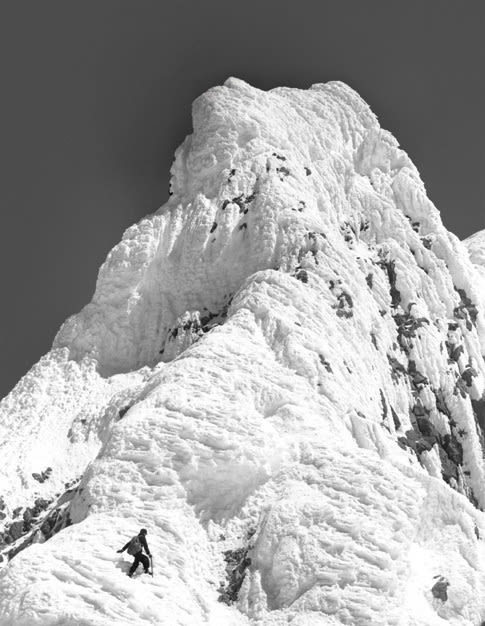Peak Season

Mount Hood, 1939: Climber Jim Mount on the First Gendarme, Yocum Ridge
Image: George Henderson
ROCKY HENDERSON had a decade of Cascades climbing experience when a simple brochure for Portland Mountain Rescue caught his eye in 1986. The 36-year-old filled out an application and was accepted by the volunteer mountain rescue organization. His first call-out came at 1 a.m. Tuesday, May 13, 1986. The mission: scour the stormy southern slopes of Mount Hood for a group of high school students.
What unfolded became the worst tragedy in Hood climbing history. Ten teenagers, two teachers, and a professional guide—all part of the Oregon Episcopal School’s annual Basecamp Wilderness Education Program—had set out that Monday morning and climbed toward the summit until 60 mph winds, driving snow, and hypothermia forced them to take refuge in a tiny snow cave. The next day, the guide and a student managed to hike to Mt Hood Meadows for help, but worsening weather battered rescuers and obliterated any signs of the missing climbers. After searchers finally found the cave on Thursday afternoon, only two students would survive.
“It’s always there in my memory,” says Henderson, who at 60 remains active with PMR. “It’s a marking stone of my mountain rescue experience.”
In the 25 years since the OES disaster, misfortune has struck repeatedly on Mount Hood. With nearly 10,000 people attempting to summit the peak every year, most of them during the prime climbing season that commences this month, it’s bound to return. And when it does, all eyes will turn to the high-country drama, and the calls for new rules, fees, and mandatory safety equipment will begin anew.
“Climbers running into problems seem to trigger people’s gut reactions,” says Henderson, “but the public doesn’t often think it through.”
In the more than 150 years since the first official ascent of Hood, at least 130 lives have been lost on or around the mountain, often in dramatic fashion. In 1999, a Hillsboro couple training for Mount McKinley slipped off Cooper Spur on Hood’s north side and fell nearly 1,500 feet to their deaths. In 2002, an Air Force Pave Hawk helicopter, attempting to evacuate one of nine people who had been swept into a crevasse, crashed into the mountain. The chopper tumbled 1,000 feet and, with live cameras rolling, steamrolled two rescuers.
Such high-profile incidents inevitably provoke calls to mandate the use of tracking beacons or require climbers to pay for their own rescues—measures that climbers and rescuers largely oppose as misguided and unfair.
Beyond sheriff’s office overtime costs, saving climbers doesn’t cost the public much. Almost all search-and-rescue operations are conducted by volunteers, and military aircraft log search-and-rescue flights as monthly training hours they’d have to fly anyway. (Oregon already has a rarely used law that allows counties to bill people—not just climbers—who are deemed grossly negligent up to $500 for search-and-rescue services.)
In the wake of the OES tragedy, concerned citizens raised money for a unique signaling device—adopted from animal-tracking technology—that climbers can activate if they get into serious trouble. Called Mountain Locator Units, they can be rented for $5 a day from local outdoor stores. But mandating MLUs or personal locator beacons could create a new set of problems. The technology is outdated and doesn’t work in all terrain. And critics of a mandate worry that requiring beacons would raise liability issues if climbers who activated the signals could not be rescued.
In the grander scheme of things, climbers require far less rescue help than most groups in Oregon’s outdoors. According to the state’s Office of Emergency Management, of the 1,069 search-and-rescue missions in Oregon in 2010, just 23 were climbing related; 130 were for hikers, 150 involved motor vehicles, and 39 concerned hunters.
“Climbers are really not that big of a problem,” notes Henderson. “It’s just that they grab the attention.”
Whether or not tragedy and controversy strike this spring, climbers will continue to be drawn to the beauty and challenge of Mount Hood’s 11,000-foot peak. Thousands will make it up and down the hill just fine. But accidents happen, and people will react.
“Mountain accidents tweak people’s interests,” says Henderson. “When climbers are lost, it’s a mystery that everybody wants to solve.”
At that point, the public—and lawmakers—need to maintain that most crucial piece of alpine gear: a cool head.



